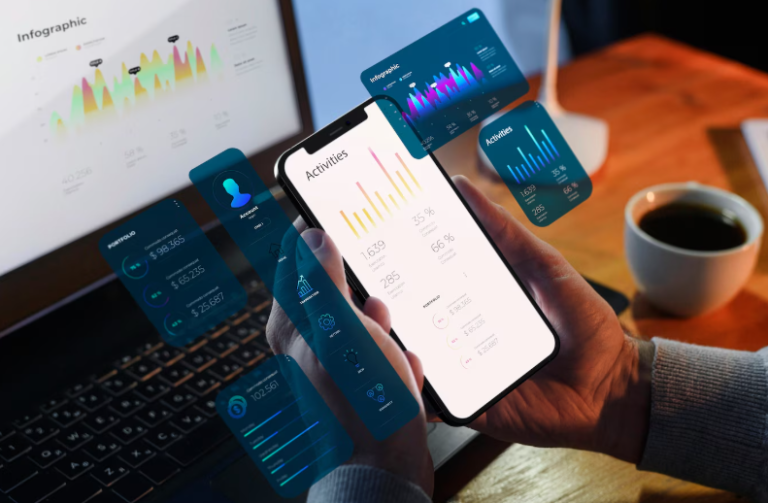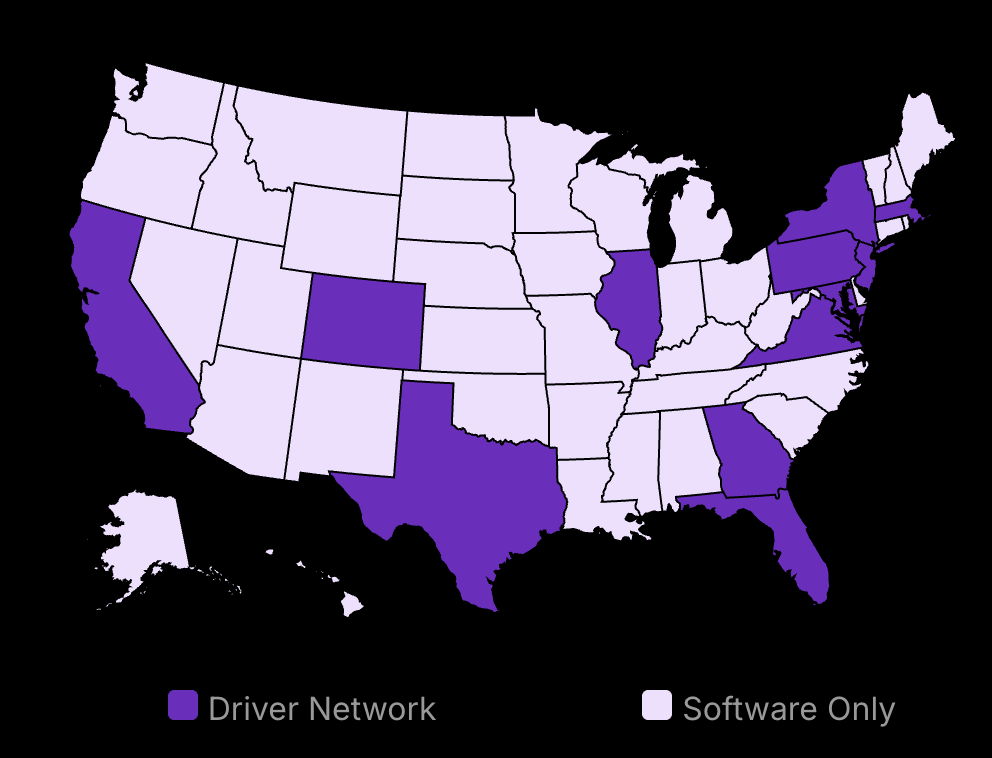I’ve seen how mobile marketing can really boost the number of customers you reach. Using phone-based advertising lets me connect with people no matter where they are. From what I’ve learned, it gets more engagement than the usual marketing methods.
Global Smartphone Penetration: As of 2024, there are approximately 4.88 billion smartphone users worldwide, accounting for about 60.42% of the global population.
This article examines six specific mobile marketing approaches that have demonstrated measurable results for businesses of all sizes. Each strategy comes with practical implementation steps to help you expand your mobile audience immediately.

Boost customer satisfaction with just a few clicks
Most-Loved Features:
- On-demand drivers
- Real-time GPS tracking
- Delivery confirmation photos
- Over 50% of customers report a smoother delivery experience
1. Quick Overview: How Mobile Marketing Boosts Reach
Mobile marketing connects businesses with customers directly on their phones through apps and location services. This marketing activity helps engage customers effectively.
It increases reach by tapping into a massive audience of smartphone users.
Delivers higher engagement rates with personalized, timely promotional messages that traditional marketing can’t match.
Mobile Internet Access: In 2024, 96.3% of internet users access the internet using a mobile phone.
What Mobile Marketing Actually Means
Mobile marketing is business communication that happens through smartphones, tablets, and other mobile devices. It includes text messages, in-app notifications, mobile-optimized emails, and social media campaigns designed specifically for mobile users on various social media platforms. This approach is crucial for any modern app marketing effort.
The power of mobile marketing comes from its direct access to customers. Unlike billboards or TV ads that hope to catch someone’s attention, mobile marketing delivers messages straight to devices people check dozens of times daily. This direct line creates immediate awareness and opportunities for action, often through carefully crafted mobile marketing content. This ability to send messages directly is a key advantage.
“Mobile is not the future, it is the now. Meet your customers in the environment of their choice, not where it is convenient for you,” said Eric Schmidt, Executive Chairman of Alphabet Inc. This insight captures why mobile marketing works – it reaches customers where they already spend their time, often on different devices.
Why Mobile Reach Matters More Than Ever
The reach of mobile marketing is truly massive. This universal adoption makes mobile an essential channel for any comprehensive marketing strategy. Consumers prefer to browse, shop, and interact with brands on their mobile devices. When people need information, they reach for their phones.
Mobile Dominance in Web Traffic: Over 63% of website traffic comes from mobile devices in 2025.
Mobile marketing also offers reach that’s impossible through other channels. For example, location-based marketing can target customers based on their physical location, allowing businesses to send relevant offers when potential customers are nearby using location-based information. This real-time, contextual approach is unique to mobile platforms and key for retaining customers.
Core Elements That Make Mobile Marketing Effective with a Solid Marketing Strategy
Mobile marketing’s effectiveness comes from several key components working together:
Immediacy and Accessibility
Mobile devices stay with customers throughout their day, making messages immediately accessible. Unlike email marketing that might be checked hours later, mobile notifications are typically seen within minutes. This immediacy creates opportunities for time-sensitive offers like flash sales and real-time engagement.
One of mobile marketing’s biggest advantages is its ability to reach customers at critical decision points. When someone searches for “coffee shops near me,” mobile marketing can deliver a targeted ad or coupon at exactly the right moment. This perfect timing dramatically increases conversion rates compared to broader marketing approaches.
Data-Driven Personalization
Mobile marketing excels through its use of customer data from data analytics to create personalized experiences. By analyzing user behavior, preferences, and past interactions, businesses can tailor messages to individual needs.
This personalization extends beyond just using someone’s name in a message. Mobile marketing can customize offers based on previous purchases, browsing history, or even current weather conditions. This level of relevance significantly boosts engagement.
Multi-Channel Integration
Effective mobile marketing doesn’t exist in isolation. It works best when integrated with other marketing channels to create a cohesive customer experience across multiple channels. A customer might receive a text about a sale, click through to a mobile website, and later see related social media content – all optimized for mobile viewing. This integration helps businesses maintain consistent messaging while reaching customers through their preferred communication channels.
Mobile Ad Spending Growth: Mobile ad spending is at 58% of total digital advertising spending around the world, expected to reach nearly 70% by 2025.
Common Mobile Marketing Misconceptions
Many businesses hesitate to invest in mobile marketing due to misconceptions about its effectiveness or complexity:
“Mobile Marketing Is Just for Big Businesses”
Small businesses often believe mobile marketing requires extensive resources or technical expertise. In reality, mobile marketing platforms have become increasingly accessible, with options for businesses of all sizes. Simple text message campaigns or location-based ads can be implemented with minimal investment while still delivering significant returns. The local nature of mobile actually makes it particularly valuable for small businesses. Having even basic mobile optimization becomes crucial for businesses of any size.
“Email Marketing Is Enough”
Some marketers believe their email campaigns adequately reach mobile users. While many people do prefer to check emails on mobile devices, mobile marketing goes far beyond email. It includes app notifications, mobile search ads, and social media – channels that often have higher engagement rates than email alone. Mobile marketing also provides unique capabilities that email can’t match, such as push notifications that appear on lock screens or location-based triggers that activate when customers enter specific areas. These tools create immediate awareness that email simply cannot achieve.
Measuring Mobile Marketing’s Impact on Customer Reach
For businesses investing in mobile marketing, measuring its effectiveness is critical. Several key metrics help evaluate how well mobile campaigns extend customer reach. Mobile conversion rates show how many users take desired actions after engaging with mobile content.
Mobile eCommerce Sales Share: Mobile eCommerce accounts for 60% of sales, yet mobile conversion rates average just 1.53%, far below desktop’s 3%.
Engagement metrics like app opens, notification click-throughs, and time spent in mobile environments help measure how effectively a campaign captures and maintains customer attention. Customer acquisition costs typically decrease with effective mobile marketing, as targeted mobile campaigns reach the right customers at the right time. This efficiency makes mobile an increasingly important channel for businesses looking to maximize their marketing ROI.
2. Location-Based Targeting: Reaching Customers Near You with Location-Based Marketing
TL;DR:
Location-based marketing uses mobile technology to send targeted messages to customers in specific geographic areas.
Implementing geofencing technology can significantly increase response rates.
Many people who search for local businesses visit one within a day.
Location-based targeting, a cornerstone of modern types of mobile marketing, represents one of the most powerful tools in mobile marketing today. This approach uses GPS, Bluetooth, and Wi-Fi signals from mobile devices to identify where potential customers are physically located, then delivers relevant content based on their proximity to your business or specific locations. These location based strategies are vital.
The concept is straightforward but powerful: when someone enters a defined geographic area, they receive tailored marketing messages. This rapid expansion highlights how businesses are recognizing the value of connecting with customers based on their physical location and how it can drive foot traffic.
Location-Based Advertising Market Growth: The global location-based advertising market size was valued at USD 128.12 billion in 2024 and is projected to grow at a CAGR of 15.0% from 2025 to 2030.
For smaller businesses especially, location-based marketing creates opportunities to compete with larger companies by focusing marketing efforts on nearby potential customers. There is a strong consumer preference for this approach.
Implementing Location-Based Targeting
Implementing location-based targeting requires strategic planning and the right technology. The first step involves selecting appropriate geofencing technology that aligns with your business goals. Geofencing creates virtual boundaries around specific locations, enabling businesses to trigger marketing actions when customers enter or exit these zones.
Most businesses begin by integrating geofencing capabilities into their existing mobile apps or partnering with platforms that offer location-based services. The implementation process typically involves:
Defining clear geographic boundaries around your stores, competitor locations, or areas where your target audience spends time.
Creating compelling, location-relevant content that provides immediate value to recipients.
Setting up automation rules that determine when and how messages are sent.
Establishing measurement systems to track performance metrics like engagement and conversion rates.
When sending location-specific content, timing becomes critical. This demonstrates the importance of reaching customers at precisely the right moment in their decision-making process.
Best practices for location-based content delivery include:
Keep messages concise and immediately relevant to the location.
Include clear calls-to-action with time-sensitive offers.
Respect privacy by getting explicit permission before collecting location data.
Test different geographic boundaries to determine optimal sizes for engagement.
Limit message frequency to avoid overwhelming customers.
Location-Based Marketing Services Revenue: The revenue generated by location-based marketing services in 2024 was USD 59.7 billion, anticipated to exhibit a Y-o-Y growth of 15.2% in 2025.
Technical Implementation Considerations
The technical aspects of geofencing implementation deserve special attention. Most businesses use either app-based geofencing (requiring users to download your app) or web-based geofencing (working through mobile browsers). App-based solutions offer more precise targeting and functionality but require users to install your application. Web-based approaches reach a broader audience but may have less accuracy.
The size of your geofenced areas matters significantly. Too large, and your messages lose relevance; too small, and you might miss potential customers. Privacy regulations strictly govern location data collection. Always implement transparent opt-in processes and provide clear privacy policies explaining how location data will be used and stored. This builds trust while keeping your business compliant with regulations.
Benefits of Being Location-Aware
The most immediate benefit of location-based marketing is increased foot traffic for physical businesses. When customers receive relevant offers while near your location, the probability of them visiting increases dramatically. This approach creates a powerful bridge between digital marketing and physical sales. For smaller businesses with limited marketing budgets, this targeted approach ensures marketing dollars are spent reaching the most promising potential customers.
Location awareness also enables enhanced personalization beyond simple proximity. By analyzing patterns in customer movement and store visits, businesses can develop deeper insights into consumer behavior. For example:
Understanding which competitors your customers also visit
Identifying peak visiting times for different customer segments
Recognizing how weather, events, or other factors affect store visits
Determining which neighborhoods or areas contain your most valuable customers
This intelligence allows for increasingly sophisticated personalization. Rather than sending the same offer to everyone near your store, you can tailor messages based on their previous behaviors, preferences, and purchase history combined with their current location. Customers respond positively to this approach and often want brands to deliver personalized content.
Ethical Considerations and Privacy Balance
While location-based marketing offers powerful benefits, ethical implementation is essential. The key is finding the balance between personalization and privacy. Successful businesses maintain transparent practices about what data they collect and how they use it.
Building trust requires giving customers control over their location data. Customers value location-based services when properly implemented. To maintain this trust, provide clear value in exchange for location data. Generic promotions rarely justify the perceived privacy trade-off, but exclusive offers, convenient services like roadside assistance updates, or unique experiences often do. This value exchange forms the foundation of sustainable location-based marketing strategies.
The question “How does marketing attract customers?” finds a clear answer in location-based targeting. By delivering relevant offers to customers already near your business, you reduce friction in the purchase decision. Marketing becomes less about convincing distant prospects and more about facilitating decisions for people already in position to take action. The most effective location-based campaigns combine the right place with the right moment and the right message—creating a powerful alignment that significantly increases conversion rates and builds stronger customer relationships.
3. Personalized Mobile Advertising: Speaking Directly To Your Audience with Digital Marketing
TL;DR:
Personalized mobile ads can significantly increase engagement over generic advertising.
Ethical data collection and analysis are the foundations of effective personalization.
Mobile personalization can lead to higher purchase intent when done correctly.
Mobile devices present a unique opportunity for personalized advertising that simply doesn’t exist in other media. Unlike TV or billboard ads that must appeal to everyone, mobile ads can be crafted specifically for each user based on their behaviors, preferences, and needs. This targeted approach results in higher engagement rates and better ROI for marketers. The shift toward personalized mobile advertising isn’t just a trend—it’s backed by clear consumer expectations for tailored experiences from brands. Many users actually become frustrated when marketing isn’t relevant to them.
Crafting Personalized Messages
The foundation of personalized mobile advertising starts with ethical data collection. This isn’t about secretly gathering information, but rather creating transparent exchanges where customers understand the value they receive for sharing their data.
Impact of Email Personalization: Personalized emails have a 29% higher open rate and a 41% higher click-through rate compared to non-personalized emails.
Ethical Data Collection Methods
First-party data collection remains the gold standard for personalization. This data comes directly from your users through:
App usage patterns and in-app behavior tracking
Account preferences and settings
Purchase history and cart abandonment data, including in app purchases
Survey responses and direct feedback
Email engagement metrics
To collect this data ethically, businesses must implement clear consent mechanisms that explain what data is being collected and how it will be used. This transparency builds trust while giving you the information needed for personalization. An often-overlooked method is progressive profiling, where you collect small pieces of information over time rather than asking for everything at once. This approach feels less intrusive to users while still building comprehensive profiles for personalization.
Behavioral Data Analysis Techniques
Once you’ve collected user data, the next step is analyzing it to identify patterns and preferences. Several techniques have proven effective:
Segment Analysis: Group users based on similar behaviors or characteristics. This might include segments like “frequent buyers,” “deal hunters,” or “product researchers.” Each segment receives messaging tailored to their specific behaviors.
Predictive Analytics: Use historical data to predict future actions. This allows you to send personalized offers before the customer even knows they want them. For example, if data suggests a customer typically buys new running shoes every six months, you can time a personalized shoe discount to arrive right as they’re considering a new pair.
AI-Powered Personalization: Machine learning algorithms can identify complex patterns humans might miss. These systems continuously improve their recommendations based on user responses, creating a feedback loop that enhances personalization over time.
“No longer will people accept viral marketing. What consumers are expecting – and craving – is a more personalized, curated experience.” – Penny Wilson, former CMO of Hootsuite. This shift in consumer expectations makes data analysis not just helpful but essential for effective mobile marketing.
Impact of Personalization on User Experience
Personalized mobile advertising dramatically improves user experience metrics across the board. Companies that excel at personalization often generate more revenue from those activities.
Engagement Metrics: The Benefits Are Clear
Personalized mobile ads consistently outperform generic messaging. These improvements stem from the basic human desire for relevance. When an ad speaks directly to a person’s current needs or interests, it stops being an interruption and starts being a service. Mobile ads personalized based on location data show particularly strong performance. This immediacy demonstrates how powerful contextual relevance can be.
Overall Cart Abandonment: The average cart abandonment rate across all eCommerce sites is 70.19%, according to Baymard Institute.
Mobile Cart Abandonment Discrepancy: Mobile users have a higher cart abandonment rate of 85.7%, compared to desktop users at 73%.
Building Long-Term Brand Relationships
Beyond immediate metrics, personalization builds stronger brand-consumer relationships over time. When customers feel understood, they develop emotional connections with brands that lead to higher customer lifetime value, increased brand loyalty, more brand advocates, and reduced price sensitivity. The psychological principle at work is reciprocity. When brands invest in understanding customers and delivering relevant experiences, customers respond with increased loyalty and spending. This creates a virtuous cycle where better data leads to better personalization, which leads to stronger relationships and even more data.
Technology Enablers for Mobile Personalization
The technological backbone supporting personalized mobile advertising has advanced dramatically in recent years, making sophisticated personalization accessible to businesses of all sizes.
Cross-Device Identity Resolution
Modern consumers use multiple devices throughout their day—from smartphones to tablets to computers. Cross-device identity resolution technology connects these separate device identities into a single user profile, allowing for consistent personalization across all touchpoints. This technology works through deterministic matching (using login credentials across devices) and probabilistic matching (using algorithms to connect devices based on usage patterns). The result is a complete picture of the customer journey, regardless of which device they’re using.
Implementing cross-device tracking requires:
A unified customer data platform
Consistent login systems across properties
Privacy-compliant tracking mechanisms
Data integration between marketing platforms
With proper identity resolution, a customer who browses products on their work computer can receive relevant mobile ads about those same products later in the day, creating a seamless experience.
Dynamic Creative Optimization
Dynamic Creative Optimization (DCO) automatically generates personalized ad creative based on user data. Rather than creating dozens of ad variations manually, DCO platforms can produce thousands of personalized versions by swapping out different elements:
Headlines and copy
Images and videos
Call-to-action buttons
Offer details
Background colors and layouts
These systems test different combinations and learn which elements perform best for each user segment. The result is truly personalized creative that speaks directly to each user’s preferences without requiring massive design resources. A/B testing at scale becomes possible with DCO, as the system can continuously optimize for the best-performing variations. This leads to constant improvement in ad performance over time.
Privacy-First Personalization
With increasing privacy regulations and the phase-out of third-party cookies, personalized mobile advertising must adapt to a more privacy-conscious approach.
Building Trust Through Transparency
Privacy and personalization aren’t opposing forces—they’re complementary when implemented correctly. The key is transparency about how customer data is used and the value they receive in exchange. Successful privacy-first personalization strategies include clear opt-in processes, easy-to-understand privacy policies, customer control over their data, and visible benefits from sharing data. Consumers are often willing to share personal data for a more personalized shopping experience, but this willingness hinges on trust.
Contextual Targeting Alternatives
As third-party cookies become less available, contextual targeting has reemerged as a powerful alternative. Rather than tracking users across the web, contextual targeting shows ads based on the content of the page they’re currently viewing. Modern contextual targeting goes beyond simple keyword matching to include semantic analysis, image recognition, and sentiment analysis. This approach respects user privacy while still delivering relevant ads. A person reading an article about hiking might see ads for outdoor gear—not because they’ve been tracked across the web, but because the ad matches what they’re currently interested in.
Measuring Personalization Success
Proper measurement is essential to understand and improve your personalization efforts. The right metrics help you quantify the return on investment and identify opportunities for improvement.
US Mobile Ad Market Size: The US mobile advertising market is expected to surpass $200 billion for the first time in 2024, reaching $202.59 billion.
Key Performance Indicators
Beyond standard marketing metrics, specific KPIs for personalization include personalization rate, relevance score, segment performance variation, personalization uplift, and progressive profiling completion. These metrics help isolate the impact of personalization from other marketing factors. Phone-based clicks can be a cost-effective channel for personalized marketing. This efficiency metric should be tracked alongside engagement metrics to understand the full ROI picture.
Advanced Testing Frameworks
Simple A/B testing isn’t enough for sophisticated personalization. More advanced frameworks include multi-armed bandit testing, holdout groups, sequential testing, and long-term impact studies. With these frameworks, you can continuously refine your personalization strategy based on real performance data rather than assumptions.
Mobile personalization presents a powerful opportunity to speak directly to your audience with relevant, timely messages. When implemented with a focus on customer value and privacy, personalized mobile advertising creates better experiences for customers and better results for brands.
4. Mobile Customer Engagement: Keeping Customers Involved through app-based marketing
Consistent mobile engagement can significantly increase customer retention.
Real-time interactions often lead to higher conversion rates than delayed communications.
Personalized mobile notifications tend to see higher open rates than generic messages.
Mobile customer engagement is the ongoing interaction between businesses and customers through mobile devices. These connections happen through apps, push notifications, and other mobile channels. Strong mobile engagement strategies can lead to higher customer retention rates. This is a key part of app based marketing.
Real-time communication stands as a powerful tool in mobile marketing. When customers receive timely notifications about offers, updates, or responses to their actions, they feel valued. Messages delivered promptly after a trigger event often have a higher conversion rate. Content that encourages interaction—like polls, quizzes, and user-generated content campaigns—creates two-way conversations rather than one-way promotions. Brands implementing interactive content, including mobile gamification, often see higher engagement rates and longer app session durations. This helps to engage customers more deeply.
Methods to Boost Engagement with in app marketing
Mobile apps have become central to customer retention strategies. Customers who install a brand’s app may spend more with that company annually compared to non-app users. This happens because apps create constant brand presence, provide personalized experiences through in app marketing, and offer convenience that builds habits.
The most effective mobile apps incorporate these engagement elements:
Push notifications with personalized offers and in app messages.
In-app rewards and loyalty programs.
Exclusive mobile-only content that creates FOMO (Fear Of Missing Out).
Social sharing capabilities that expand reach organically.
Companies investing in their mobile app experience may see an increase in customer lifetime value.
Responsive customer service through mobile channels has become equally important for engagement. When customers can reach support through their preferred mobile channels—whether in-app chat, short message service, or social messaging—resolution speeds can increase.
Key components of effective mobile customer service include:
24/7 chatbot availability for common questions with seamless human handoff.
In-app support options that don’t force channel switching.
Visual support tools like screenshot capabilities and video chat.
Proactive service notifications before customers even notice issues.
Businesses implementing comprehensive mobile support strategies often report higher customer satisfaction scores and lower support costs.
Measuring Engagement Success in App Marketing
Tracking the right metrics is essential for understanding and improving mobile engagement. The most valuable engagement metrics include:
Active users (daily, weekly, monthly) – measures your reach
Session length and frequency – indicates content value
Retention rate – shows staying power
Conversion rate – demonstrates effectiveness
Notification opt-in and open rates – reveals communication relevance
Google Analytics for Mobile Apps and Firebase provide comprehensive tracking capabilities for these metrics. For more advanced analysis, tools like Mixpanel and Amplitude offer user journey mapping and cohort analysis to identify patterns in how different user segments engage with your mobile content. The most successful companies establish clear KPI benchmarks based on industry standards.
From Data to Action
Collecting engagement data is only valuable when it drives improvements. Successful brands use these approaches:
A/B testing different notification formats and timing.
Heat mapping in-app interactions to identify friction points.
User journey analysis to find drop-off moments.
Cohort comparisons to understand which segments engage best.
Starbucks exemplifies this data-driven approach. After noticing lower engagement with certain app features, they ran tests that led to a redesigned rewards program interface, which reportedly increased mobile order frequency.
Customer feedback forms the final piece of the engagement measurement puzzle. Mobile platforms offer unique opportunities to gather instant reactions through:
In-app surveys (keep them under 3 questions)
Rating prompts at key moments
Feedback widgets within the experience
Social listening for unsolicited opinions
When Target implemented post-purchase feedback collection through their app, they identified and fixed major pain points, reportedly resulting in a decrease in cart abandonment. The most effective feedback systems close the loop by showing customers how their input led to changes. This “feedback loop” can increase future participation rates.
Mobile engagement directly impacts customer loyalty and retention. When customers regularly interact with a brand through mobile channels, they may be more likely to make repeat purchases. This happens because mobile platforms create micro-moments of connection throughout the day, building emotional bonds through consistent presence.
The connection between mobile marketing and customer loyalty stems from three key factors:
Accessibility – customers can engage anywhere, anytime
Personalization – mobile data enables highly relevant experiences
Immediacy – real-time responses create stronger connections
When brands integrate these elements effectively, they create what researchers call “loyalty loops” – self-reinforcing cycles where positive mobile interactions lead to increased brand preference, which leads to more engagement.
5. Secondary Benefits: Beyond Direct Reach via multiple marketing channels
TL;DR:
Mobile marketing extends beyond customer acquisition to significantly boost overall brand recognition.
Strategic mobile presence creates cohesive customer experiences across all marketing channels.
When implemented correctly, mobile becomes the glue holding together comprehensive marketing strategies.
Strengthening Brand Awareness
Mobile marketing extends far beyond simple customer acquisition – it fundamentally shapes how consumers perceive and remember your brand. When businesses integrate mobile strategies into their marketing mix, they’re not just reaching more people; they’re creating lasting impressions that stick with consumers throughout their day. Mobile search optimization is essential for brand discovery. This represents a critical touchpoint where consumers form their first impressions of your brand. If your mobile presence is lacking, potential customers may never encounter your business at all. The initial moments of discovery often determine whether a customer continues their journey with your brand or bounces to a competitor.
The connection between mobile marketing and brand perception runs deep. Users often report having a higher opinion of mobile-friendly websites compared to those that aren’t optimized for smaller screens. This isn’t surprising when we consider how frustrating it is to navigate poorly designed mobile sites. The psychological impact of these experiences shapes brand perception on both conscious and subconscious levels. Users associate the quality of their mobile experience directly with the quality of the brand itself.
Consistency Across Brand Touchpoints
Brand consistency across mobile touchpoints creates a powerful cumulative effect that strengthens recognition and recall. Each mobile interaction – whether through an app, mobile site, or social media – should reflect your brand’s visual identity and voice. When these elements align, they reinforce each other, creating a stronger overall impression than any single touchpoint could achieve alone.
The strength of this approach becomes clear when we examine social media usage patterns. A vast majority of users on popular social media platforms access them via mobile devices. These platforms represent crucial brand awareness channels where consistency matters tremendously. Brands that fail to optimize their content for mobile viewing miss enormous opportunities to strengthen their market position.
Eric Schmidt, Executive Chairman of Alphabet Inc., captured this necessity perfectly when he said, “Mobile is not the future, it is the now. Meet your customers in the environment of their choice, not where it is convenient for you.” This statement cuts to the heart of modern brand building – meeting customers where they already are, rather than expecting them to seek you out.
Supporting Omnichannel Efforts
Mobile devices have become the central hub connecting all marketing channels, making them the backbone of effective omnichannel strategies. The true power of mobile marketing emerges when it’s integrated with other channels to create seamless customer experiences regardless of where and how customers interact with your brand.
The numbers tell a compelling story about mobile’s central role in cross-channel marketing. Many people prefer checking emails on mobile devices, with a significant portion of all email views coming from mobile. This connection between email marketing and mobile experience highlights why campaigns must work across channels. When a customer receives an email promotion and clicks through to your website, that transition must be smooth and consistent, maintaining the same messaging, offers, and visual identity throughout.
Similarly, a large percentage of pay-per-click (PPC) advertising clicks now come from mobile devices. This creates another critical junction point where consistency matters. When customers click a mobile ad, they expect the landing page to deliver exactly what was promised, formatted perfectly for their device. Any disconnection in this experience damages both conversion rates and brand perception.
The Mobile Bridge Between Online and Offline
Mobile devices create unique opportunities to bridge online and offline marketing efforts. Location-based marketing, QR codes, and mobile loyalty programs all connect physical world experiences with digital ones. This integration can transform how customers interact with your brand across their entire journey. The near-universal adoption of mobile devices makes this channel uniquely positioned to connect all marketing efforts. No other platform offers such broad reach combined with personal connection. This positions mobile as the ideal foundation for omnichannel strategies.
As Jill McFarland from Stellar Digital Marketing notes, “Today’s guests aren’t searching on desktops for where to go for dinner — they are walking down the street. They crave a burger, pull out their phone and search for a nearby burger joint. If you’re not maintaining your local properties, you’re not going to show up in those search results.” This practical example shows how mobile connects online search with physical store visits, highlighting the real-world impact of integrated strategies that can drive foot traffic.
Data Enrichment and Customer Insights
Mobile marketing generates rich customer data that benefits your entire marketing ecosystem. Every tap, swipe, and interaction provides valuable insights that can inform strategy across all channels, creating a feedback loop that continually improves marketing effectiveness. The behavioral data collected through mobile interactions reveals patterns that would otherwise remain invisible. These insights help marketers understand when customers are most receptive to messages, which content formats drive engagement, and how customers move between channels during their buying journey. This knowledge can then shape everything from content creation to media buying across all marketing efforts.
Mobile data collection also enables more sophisticated customer segmentation. By analyzing how different customer groups interact with mobile content, marketers can create more targeted campaigns across all channels. This refined approach leads to higher conversion rates and more efficient marketing spend, benefiting the entire marketing program.
Building Comprehensive Customer Profiles
The personal nature of mobile devices makes the data they generate particularly valuable for creating detailed customer profiles. Unlike shared computers or household TVs, mobile phones are typically used by just one person, making the data collected through them more accurately tied to specific individuals. These comprehensive profiles help marketers understand the complete customer journey, not just isolated interactions. When combined with data from other channels, mobile insights create a 360-degree view of customer behavior that drives more effective marketing across all touchpoints. This holistic understanding becomes particularly valuable when developing personalized marketing strategies that speak directly to individual customer needs.
Seth Godin captures the essence of why this matters when he says, “People do not buy goods or services. They buy relations, stories and magic.” Mobile data helps marketers understand which relations and stories resonate with their customers, allowing them to create more meaningful connections across all marketing channels.
Cost Efficiency Through Channel Integration
Integrating mobile marketing with other channels creates cost efficiencies that benefit the entire marketing budget. When mobile strategies work in harmony with other efforts, the overall impact exceeds what could be achieved by investing the same resources in separate, disconnected campaigns. Mobile marketing receives a significant portion of U.S. marketers’ overall budgets, reflecting its growing importance. However, the true value comes not just from this direct investment, but from how mobile enhances the performance of other channels. For example, when social media campaigns include mobile-optimized landing pages, conversion rates typically increase across the board, improving the ROI of social media spending.
The projected growth in mobile ad spending demonstrates that marketers recognize this value. This investment continues to grow because businesses see concrete returns when mobile is properly integrated into their overall marketing strategy.
Reducing Redundancy Across Channels
Channel integration through mobile reduces wasteful redundancy in marketing efforts. Instead of creating completely separate campaigns for each channel, integrated approaches allow core assets, messaging, and targeting strategies to be adapted across platforms. This streamlined approach reduces production costs while maintaining consistent brand presence. The efficiency gains become even more significant when considering customer acquisition costs. Integrated mobile strategies often reduce the cost per acquisition by creating multiple touchpoints that work together to move customers through the purchase funnel. Rather than each channel working independently to convert customers, they function as a coordinated system with mobile often serving as the final conversion point.
As Wendy Clark, former SVP at Coca-Cola and now CEO at DDB Worldwide, stated, “If your plans don’t include mobile, your plans are not finished.” This sentiment reflects the essential role mobile now plays in creating complete, efficient marketing strategies that maximize return on investment across all channels.
Competitive Positioning and Market Differentiation
Strong mobile marketing integration creates competitive advantages that extend far beyond direct customer acquisition. Brands with sophisticated mobile strategies often position themselves as industry leaders, gaining market share through perceived innovation and customer-centricity. This positioning effect is particularly powerful when competitors lag in mobile optimization. Customers increasingly expect seamless mobile experiences, and brands that deliver them stand out significantly. This differentiation can shift market dynamics even in established industries, allowing forward-thinking, tech savvy companies to capture market share from larger competitors with less agile marketing approaches.
The data supports this competitive advantage. With significant mobile advertising spending, brands that deploy these resources strategically gain visibility advantages that extend across their entire marketing presence. This visibility translates directly into brand recognition that benefits all marketing channels.
First-Mover Advantages in Mobile Innovation
Brands that adopt new mobile marketing technologies early often enjoy lasting competitive advantages. Whether implementing augmented reality features, advanced personalization, or innovative mobile payment options, first movers capture attention and create associations with innovation that persist long after competitors catch up. These innovation advantages extend beyond the mobile channel itself. When customers experience cutting-edge mobile interactions, they often develop higher expectations for the brand across all touchpoints. This halo effect creates positive brand associations that benefit everything from retail experiences to customer service interactions.
Ann Handley’s advice rings particularly true here: “Make your content about your customers, not about you. Make the customers the hero.” Mobile innovations that genuinely improve customer experiences, rather than simply showcasing technology, create the strongest competitive advantages. When these improvements align with broader brand positioning, they strengthen market differentiation across all channels.
6. Supplementary Information: Understanding Key Concepts in Mobile Marketing
Mobile marketing success requires mastery of specific terminology and awareness of current challenges.
New technologies like AI and voice search are reshaping how brands connect with mobile users.
Effective measurement frameworks help businesses track ROI and optimize campaigns.
Mobile Marketing Terminology, including in-game mobile marketing concepts
The mobile marketing landscape has its own language that professionals need to understand to create effective campaigns. One key concept is geofencing, a location-based service that creates virtual boundaries around physical locations. When users enter these predefined areas, they can receive targeted notifications or offers. For example, a retail store might set up a geofence within a 1-mile radius to send special promotions to nearby shoppers. This approach can lead to increased conversion rates. The concept of in game mobile marketing, where advertisements or brand integrations appear within mobile gaming environments, is another specific area gaining traction, especially to reach a dedicated mobile gaming audience.
Personalization refers to tailoring marketing content based on user data and behavior. This goes beyond simply addressing users by name—it involves creating deeply relevant experiences based on past purchases, browsing history, location, and demographic information. Users often have a higher opinion of mobile-friendly websites that offer personalized experiences. This personalization can range from product recommendations to custom content sequencing, all aimed at creating a more relevant user journey.
Engagement in mobile marketing describes meaningful interactions between users and a brand’s mobile presence. These interactions can include app opens, notification responses, time spent browsing, and conversions. The most sophisticated mobile marketers track engagement across multiple touchpoints to build a comprehensive view of the customer journey. High engagement correlates strongly with customer retention.
Another essential term is “attribution modeling,” which tracks which marketing touchpoints contribute to conversions. Mobile marketers use various attribution models—first-touch, last-touch, multi-touch—to understand campaign effectiveness. The book “Mobile Marketing Strategy” by Alexander Stigson provides an excellent deep dive into attribution modeling approaches for mobile campaigns. Understanding these different types of mobile marketing is crucial.
Common Challenges in Mobile Marketing
Privacy concerns stand as one of the biggest challenges facing mobile marketers today. With increasing regulations, brands must carefully balance personalization with data protection. The core issue isn’t just legal compliance but building genuine trust with consumers. Some mobile users may abandon a website or app if they feel uncomfortable with the data being collected.
Data protection goes beyond regulatory compliance—it requires a fundamental shift in how companies think about user information. Best practices include implementing transparent data collection policies, obtaining explicit consent, and providing users with control over their data. Companies leading in this area are adopting “privacy by design” approaches, where data protection is built into systems from the ground up rather than added as an afterthought.
Technical fragmentation creates another significant hurdle. The mobile ecosystem spans numerous devices, operating systems, and screen sizes. Developing experiences that work consistently across this diverse landscape requires substantial resources. This challenge is particularly acute for smaller businesses with limited technical teams. The fragmentation extends to ad formats and platforms as well—each major ad network has its own specifications and best practices.
Solving the Cross-Platform Challenge
Cross-platform development frameworks like React Native and Flutter have emerged as potential solutions to the fragmentation problem. These tools allow developers to write code once and deploy across multiple platforms, potentially reducing development costs. However, they come with tradeoffs in performance and native functionality that marketers must carefully weigh.
Another growing challenge is ad fatigue and banner blindness. As mobile users are exposed to more advertisements, their attention becomes harder to capture. Declining engagement pushes marketers to develop more innovative formats and targeting strategies. Native advertising that blends seamlessly with content has emerged as one effective response to this challenge.
Future Trends, including augmented reality
The mobile marketing landscape is constantly evolving, with several emerging technologies poised to reshape how brands connect with customers. Voice search is gaining significant traction, with many online searches occurring on mobile devices. As voice-activated assistants become more sophisticated, brands are developing voice-optimized content and advertising strategies. This shift requires marketers to think about conversational keywords and natural language patterns rather than traditional text-based search optimization.
Augmented reality (AR) is moving beyond novelty applications to become a practical marketing tool. Furniture retailers now let customers visualize products in their homes, cosmetics brands offer virtual try-on experiences, and clothing retailers provide virtual fitting rooms. These AR applications are showing promising results, potentially increasing conversion rates when products include AR experiences. The technology is becoming more accessible as development platforms mature and smartphone hardware improves.
5G technology will dramatically increase mobile data speeds and reduce latency, enabling richer media experiences and more sophisticated real-time applications. This technological leap will allow marketers to deliver high-definition video, complex interactive experiences, and immersive AR/VR content without performance concerns. Early adopters in countries with established 5G networks are already seeing higher engagement rates with rich media content.
The Role of AI in Personalizing User Experience with Conversational Marketing
Artificial intelligence is transforming mobile marketing from basic personalization to truly predictive experiences. Machine learning algorithms now analyze vast amounts of user data to predict preferences, anticipate needs, and deliver highly targeted content. For example, AI systems can identify which users are likely to churn and trigger retention campaigns before they leave. The book “AI-Powered Marketing” by Jim Sterne provides excellent case studies on how brands are implementing these technologies. This is where conversational marketing, powered by AI, can truly shine by enabling dynamic, personalized mobile messaging.
AI-driven personalization goes beyond simple demographic targeting to create dynamic experiences that adapt in real-time to user behavior. These systems can optimize everything from send times for notifications to the specific creative elements shown to each user. Companies implementing AI personalization often report increases in engagement rates and conversion rates compared to traditional segmentation approaches.
Natural language processing (NLP) is enabling more sophisticated chatbots and virtual assistants that can handle complex customer interactions. These AI assistants are becoming increasingly important touchpoints in the customer journey, handling everything from initial product discovery to post-purchase support. The most advanced implementations combine NLP with user data to provide personalized recommendations and support.
Measuring the Success of Mobile Marketing Campaigns
Effective measurement frameworks are essential for optimizing mobile marketing efforts. Key performance indicators (KPIs) vary depending on campaign objectives but typically include metrics like app downloads, active user rates, session length, and conversion rates. More sophisticated marketers also track lifetime value (LTV) to acquisition cost ratios to ensure sustainable growth. A significant portion of pay-per-click (PPC) ad clicks now come from mobile devices, making mobile-specific measurement crucial for accurate campaign assessment.
Attribution modeling has become increasingly complex in the mobile ecosystem. Traditional last-click attribution fails to capture the multiple touchpoints in a typical customer journey. Advanced marketers are adopting multi-touch attribution models that assign weighted value to each interaction along the path to conversion. These models provide a more accurate picture of which channels and campaigns drive results.
Tools and Technologies for Tracking Campaign Effectiveness
The technology stack for mobile measurement typically includes several integrated tools. Mobile analytics platforms like Firebase and Mixpanel track in-app behavior and user flows. Attribution platforms such as AppsFlyer and Adjust connect user acquisition sources with downstream actions. Marketing automation tools then use this data to optimize campaigns and personalization efforts.
Deep linking technology has become essential for connecting digital advertising directly to specific in-app experiences. These links maintain context across the app installation process, allowing marketers to deliver seamless journeys from ad to conversion, which directs users efficiently. Implementing deep linking can significantly increase conversion rates.
A/B testing frameworks allow marketers to systematically optimize every element of the mobile experience. The most effective testing approaches focus on learning rather than simply chasing short-term metrics. This means developing clear hypotheses, running tests with statistical significance, and building on insights over time. Books like “Experimentation Works” by Stefan Thomke provide excellent frameworks for building a testing culture.
Building an Effective Mobile Marketing Team
Creating successful mobile marketing campaigns requires specialized skills that many traditional marketing teams lack. The ideal mobile marketing team combines technical understanding, creative capabilities, and analytical skills. Key roles include mobile strategists who understand the platform’s unique characteristics, data analysts who can extract actionable insights, and developers who can implement technical solutions.
Organizational structure significantly impacts mobile marketing effectiveness. Companies seeing the best results typically integrate mobile specialists with broader marketing teams rather than isolating them in silos. This integration ensures mobile considerations are built into campaigns from the beginning rather than added as an afterthought.
The rapid evolution of mobile technology means continuous learning is essential for marketing teams. Successful organizations establish formal training programs and allocate time for experimentation with new platforms and technologies. Many companies now dedicate resources to testing emerging channels and formats before they become mainstream.
Conclusion
Mobile marketing isn’t just a trend—it’s becoming essential as customers spend more time on their phones. The six data-backed strategies we’ve explored show how businesses can connect with customers wherever they are. Location-based targeting brings nearby customers to your door, while personalized advertising speaks directly to individual needs. Real-time engagement keeps your brand top-of-mind, and these approaches strengthen overall brand awareness.
As phones become even more central to daily life, these mobile strategies will only grow more important. The businesses that succeed will be those that respect user privacy while delivering relevant, timely content to customers on the go. In addition to mobile marketing strategies, incorporating sustainable practices into your marketing plan can significantly enhance your brand’s appeal. Green marketing emphasizes environmental responsibility and resonates with increasingly eco-conscious consumers. By learning from real cases and applying practical tips on sustainable promotion, businesses can build trust and differentiate themselves in the marketplace. For those interested, this comprehensive guide on effective green marketing offers valuable insights and actionable advice.
Start small by implementing one approach—perhaps geofencing for your local business or personalized notifications for your online store. Test, measure, and refine your strategy based on customer response. Remember that effective mobile marketing helps you reach customers wherever they are, creating connections that drive loyalty and growth. Incorporating sustainability into your mobile marketing can also enhance brand appeal and customer loyalty. Green marketing strategies emphasize eco-friendly practices and communicate your company’s commitment to sustainability. Many consumers today prefer brands that align with their environmental values. Learn more about how to create impactful campaigns by exploring real examples and practical tips in our detailed green marketing strategies guide.
Your customers are mobile. Now your marketing can be too. Understanding how to differentiate your brand is crucial in today’s competitive market. Crafting a compelling unique selling proposition (USP) can set your business apart and attract more customers through mobile marketing channels. For inspiration on creating strong USPs that resonate, check out these top unique selling proposition examples that highlight what makes a brand special and memorable.





























